Which fire extinguisher should you choose? There are different types of fire extinguishers available and each one is used for a specific class of fire. Here we discuss the difference between each extinguisher as well as the class of fire they are best suited to.
Powder Fire Extinguishers

A dry powder fire extinguisher is extremely versatile, suitable for use on Class A (combustible materials), Class B (flammable liquids) and Class C (flammable gases) fires. It’s, for this reason, they’re known as ‘ABC’ extinguishers. This extinguisher smothers fires by producing a thick barrier between the fuel and the source of oxygen.
A powder fire extinguisher shouldn’t be used in confined spaces because the powder can easily be inhaled and it leaves a residue that can be difficult to clean up. Consider this extinguisher for premises including garage forecourts, commercial boiler rooms and workspaces that feature welding.
CO2 Fire Extinguishers

A CO2 fire extinguisher contains pure carbon dioxide. It works to suffocate the fire by transferring the oxygen it needs to burn. This type of extinguisher is suitable for Class B fires (flammable liquids like petrol or oil) but it’s also recommended for electrical fires thanks to the fact it’s non-damaging to electrical equipment and machinery. Premises that would benefit from incorporating a CO2 fire extinguisher include modern offices, kitchens and server rooms.
Foam Fire Extinguishers

Most commonly used on Class B fires (flammable liquids), a foam fire extinguisher is also a recommended choice for Class A risk areas (those featuring combustible materials). These extinguishers perform a cooling function and quickly smother burning materials, while the foaming agent helps prevent the fire from reigniting. Foam fire extinguishers shouldn’t be used on kitchen fires or those with an electrical source. However, they’re ideal for office environments, hospitals, schools and other spaces where organic materials play a large role in the landscape.
Water Fire Extinguishers

A water-based fire extinguisher is a popular choice for Class A fires (combustible materials). Water fire extinguishers work by cooling the fuel and ensuring it burns at a much slower pace until the fire is extinguished.
Most premises are required to have a water or foam extinguisher, so they’re often found in busy places like offices, schools and hospitals. With a low cost price, ease of maintenance and the fact they’re an environmentally friendly option, it’s easy to see why water fire extinguishers are a preferred choice for many businesses.
Wet Chemical Fire Extinguisher
A wet chemical fire extinguisher is specifically designed for use on Class F fires (cooking oils and fats), making it the ideal solution for the demands of commercial kitchen and canteen environments. This type of extinguisher works by creating a layer of foam on the burning oil or fat, stopping the supply of oxygen so the fire isn’t fuelled any further.
Download our Extinguisher Guide – a simple visual that illustrates which type of extinguisher is suited to each class of fire.
